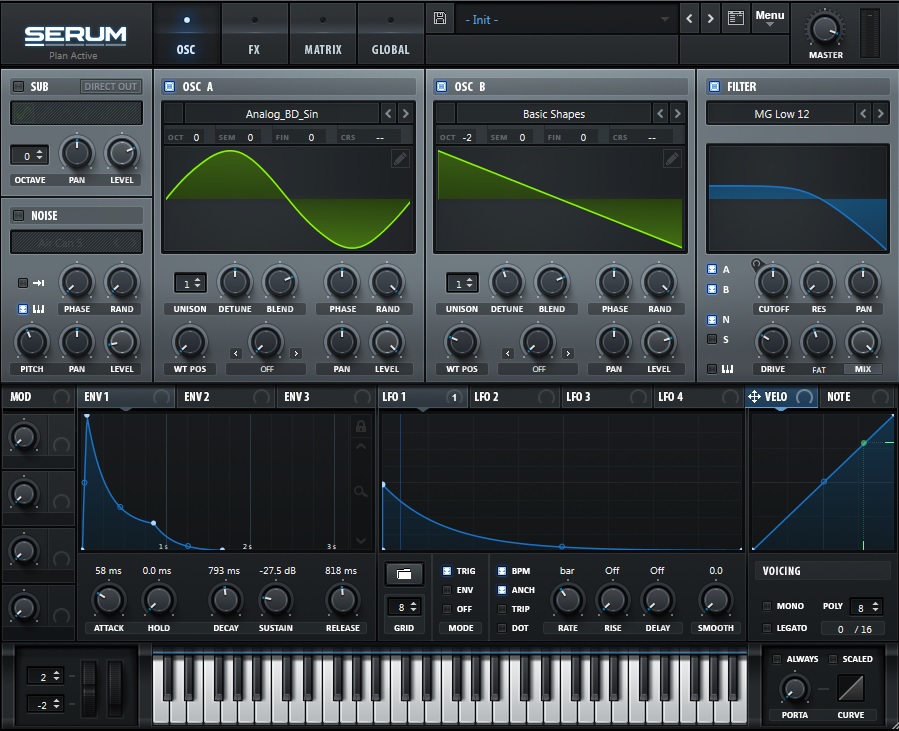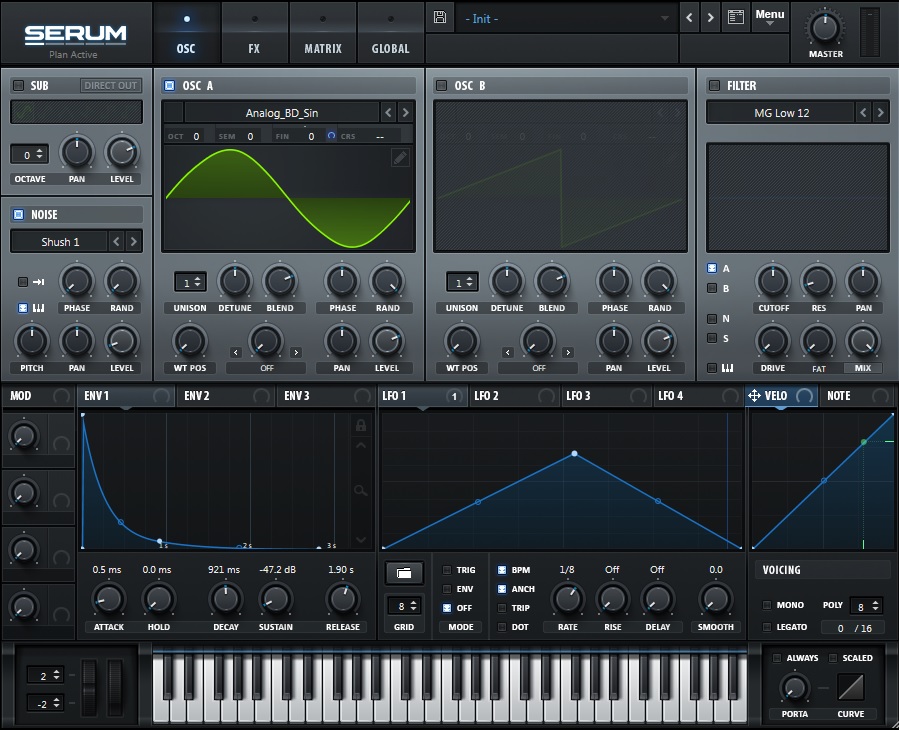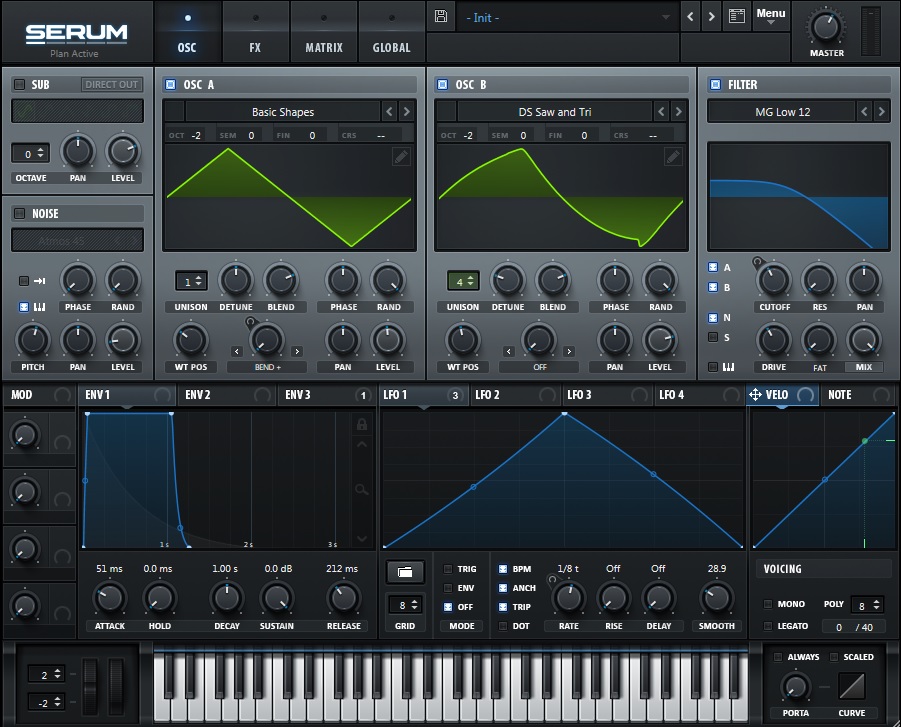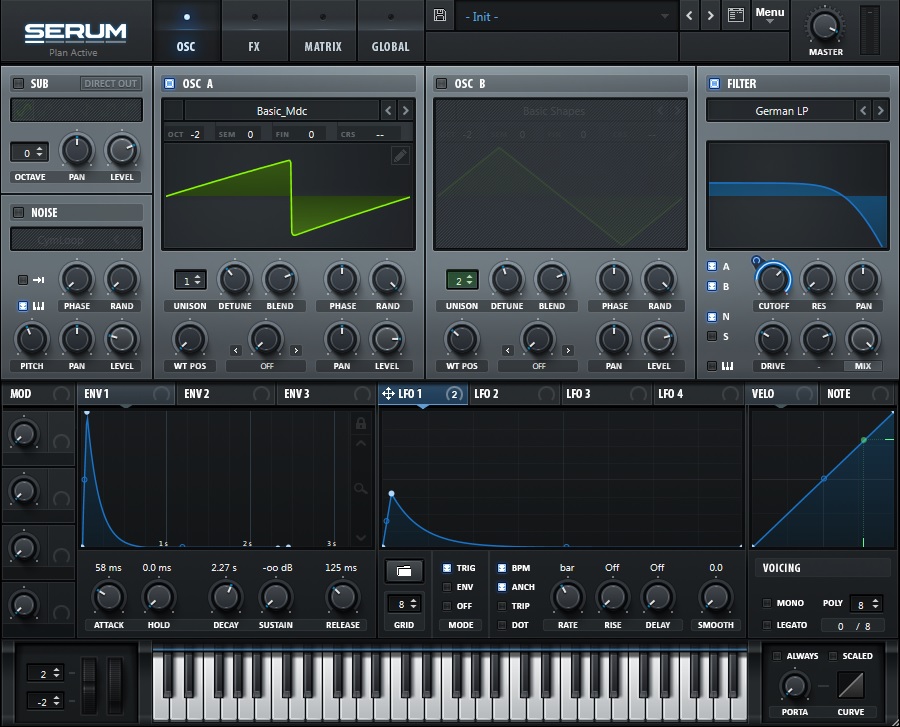In one of my previous blogs I spoke a bit about the synthesis in this track and why I chose to make things sounds the way they do. Well I didn't go into much detail about how I actually achieved those sounds so this blog is dedicated to the sounds I've created for this project through synthesis.
The general idea of this track, as I mention is my previous blog, was to keep the foundation of all the sounds fairly simple as it is mostly inspired by Minimal DnB. The drums follow a simple pattern with little variation and the synths and bass lines are built to compliment that. Most of the research I have done in reguards to how I should create these patches was for the bass lines, I am pretty versed in creating my own synth patches so I took it upon myself to come up with the sounds for the lead synths.
All of these synth patches are made using Serum.
Lead synths
The first synth featured in the track is a kind of washy and airy sound with a bit of grit to match the dark a brooding feel of the track. Again, it's built simplistically, oscillator A is a sine wave that adds some high and mid tones, and oscillator B is a saw wave carrying most of the lower end. The kind of synthesis I have used for this sound is subtractive, meaning that I've used filters to take away certain frequencies. In this instance I've used a low pass filter with a fairly quick decrease in sustain to round off the sound while still allowing the bite and grit of the saw wave to peek through. Adhearing to the simplicity of the track I haven't done much else in way of synthesis so the sound relies mostly on effects like reverb to push it back behind the mix and give it that washy sensation. The sequencing is fairly simple too, I didn't have a particular key in mind when writing this line, but more on that later as this wasn't the first sequence I wrote when beginning the track.
The second synth in the track slowly builds into the mix with an arpegiated sequence (first sequence pictured) built around a C#maj7 chord. Again, I wrote this sequence by ear without taking much notice of what key I was writing in as I don't really have a huge musical knowledge when it comes to chords and key signatures (I actually found out that I was writing a C#Major7 chord by using this What Key Am I In? online tool). As it reaches the end of it's fade into the track it switches to another sequence (the second seqeuence pictured) which becomes the main melody line. This was the first sequence I wrote so it is the basis of all other lead synth seqeuences. The synthesis isn't really much to write home about, it's simply a sine wave with a bit of noise from Serum's noise generator to make it a bit interesting, and an LFO modulating the pitch just slightly so it doesn't sound too "clinical" and stale. The release on the main envelope is turned up to about 12 o'clock to really give the sound a lot of space, and I have just ever so slightly increased the attack to soften it up a bit and releive it of that any clicky sounds you might get from a sine wave hitting immidiately.
I believe these synths match the simple, dark and airy feeling I was going for in the track, but they're probably not the only top line synths I will use. In my first blog I mentioned I was going to track some guitar for this track but after some thought I decided that guitar wouldn't really fit the style I was going for. More on that in a later blog!
Bass Synths
This is the bass we hear in the first chorus of the song, it is based around a sub frequency bass sound found quite often in early DnB tracks and often in Minimal DnB. Relying mostly on the sub frequencies to fill out a song is a trait of early Dubstep and DnB tunes have adopted a similar technqiue through out the years as well. Here is a Dubstep track that has a focus on the sub bass and a DnB track with a similar style of sub frequency bass synthesis.
I wanted to keep this simplicity of this style, while still adding some elements of my own usual sound, so the bass that i have written follows a simple sequencing but modulates using subtractive synthesis within Serum. It's made using a triangle wave (Osc A) and a wave table that mixes a saw wave and a triangle wave together (Osc B). Osc A carries most of the sub frequencies while Osc B is making use of unison to fill out the rest of the sound. A handy website called Innovative Synthesis describes unision much better than I can, "The effect of unison is simply to multiply the signal which is being produced by the synthesizer, and in most cases to detune each signal against the other (just like detuning oscillators). This creates a much bigger sound, and is especially useful for making up a lack of oscillators." I've also discovered that because unison spreads the wave form out between he left and right channels, it somewhat separates it from the triangle wave which remains mono. Both wave forms are played at similar frequencies so separting them like this allows the triangle wave to run clean underneath the more interesting frequencies in the mid range. Using an EQ I was able to take away some of the mid frequencies and to boost the high frequencies, giving it that kind of gritty sound. I've also used FL Studios Multiband Compressor to separate the sub frequencies from the mid and high and also just slightly compress the mid and lower frequencies just to keep them a little more controled. I love this plugin because you can easily allow those gritty mid and high frequencies to be heard nice and clear while the sub travels underneath. The controls for separating frequencies are picture on the left of the plugin below. The shapes represenet different frequency bands (sub to high from left to right) and as you can see, I've moved the sub frequencies just outside of the mid range to separate the two.

The second bass is heavily inspired by the kind of bass you might find in a Jump Up or Clownstep DnB track, which I spoke about in my last blog. The wavetable I've chosen for this synth is a kind of saw wave, and all I've done is put a short attack, short release envelope on a low pass filter to make it short and punchy. In the effects section of Serum there is Softclip distortion effecting the wave form which brings out those nice gritty high ends I was aiming for with the previous bass line. Osc B is turned off with this patch, although you probably noticed that unision is turned up to 2 voices on this oscillator, but that was because I thought another waveform might add some interesting mid tones to the sound but decided to stick with simplicity and keep it to one oscillator. I've also used some of the techniques I mentioned earlier with FL's multiband compressor to remove the sub frequencies from the mid and high range. As for the sequencing the first sequence pictured is the main line that you hear at the start of the second chorus. It mostly follows the kick drum in order to give it a bit more impact and bounces around in a similar fashion to the bass-line in Bricks Don't Roll by DJ Hazard. The second sequence pictured finishes off the first part of this chorus and brings it to a kind of resolution. The second part of the chorus after a short break is the same sequence as the first half, but sliced up and reshuffled to create a different but still familiar line.
I'm pretty happy with these bass-lines, they pretty accurately match the styles that I planned to emulate and fit nicely into this kind of track.
Well I think I've talked enough, hope you didn't fall asleep during that deep dive into each of the 4 synths I used for this track. While they're not the most complex synth patches I've ever made, I am pretty proud of them because of how similar they sound to the kind of synthesis I was aiming for. I think generally when I create synth patches I just mess around until I find something interesting, rather than having a specific sound in mind, so this practice is definitely beneficial to me because next time I sit down to make some new synth patches I might have a bit more direction.




















Comments